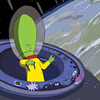-
Par Enchanteur le 23 February 2019 à 11:04


The story is mostly the same style as season 1, written by scriptwriter Song Jae-Jung. - A fast paced story, without time-out.
- No unnecessary or filling scenes.
- Use of secondary scenes to clarify the plot, render the characters, with a rich content in itself.
- Frequent and surprising twists and turns, major plot-twists.
- Cliffhangers almost omnipresent.
- Unpredictable.
- Depth on the psychological and existential levels.
- Many cult, emblematic, visually striking scenes.
- Chilling scenes that give you goose bumps.
- Comedy using situations rather than slapstick.
- Jubilant, two-way conversations, surrealist, due to the "mise en abîme".
- Strong and sincere emotions, as in all dramas.
- Romance and poignant situations to break your heart.
- Emotional rollercoaster.
- Action, suspense and a dose of horror.
- A story that crosses the boundaries of Imagination.

Add to that, the specificities of season 2 are as follows... - Respect of the manhwa rules from season 1, but I don't re-use all of them.
- Coherent interpretation of the paranormal phenomena of season 1.
- More explanations, reinforcing the logic, make it easy to understand.
- A few reminders for people who haven't watched season 1.
- New rules and unknown phenomena from the W concept.
- Go further, to compensate that Season 1 already established the concept.
- Cohesion from beginning to end, like a gigantic puzzle.
- A tangle of situations and meanings overlapping over the entire plot.
- A few more comedy scenes during part 1.
- Several main characters, although there is a more important duo.
- A plot that goes crescendo from beginning to end.
- More spectacular. (well, I don't have budget limits, but now CGI are great)
- Philosophical and psychological themes different from those of Season 1.
- Timeless universal archetypes, Korean equities (but I'm not korean, so I just try).
- Characters from W season 1, to avoid repeating the initial themes/riddles, and go further.
- Of course, some new characters too.
- Some quite harsh or disturbing situations, but without any mature content.
- An original and complete development of the W concept.
- A story that goes beyond Imagination. ^^ your comment
your comment
-
Par Enchanteur le 23 February 2019 à 11:14


"W2 four worlds" is not a book or a fan fiction, it's a drama script. This script is structured to be later transformed into a screenplay, usable in the production environment. 
The specificities of a script compared to a novel are as follows... - The story is spread over episodes that are all supposed to be of the same length.
- Each episode is divided into numbered scenes.
- Only scenes that would be seen on a screen are told.
- Descriptions are limited to what can be seen at screen, in each scene.
- There is almost no out-of-context element told by a narrator, such as a historical summary.
- There is no internal description of the characters' states of mind, or of aside on their past life.
- The story is always written in the present stance.
- Descriptions are kept to a minimum in an effort to be concise.
- The literary style, without being totally absent, is simple and direct.
- Some screenplay elements are already integrated in the script.
As a result of all this, the pace of the story is 3 to 6 times faster than in a book.  your comment
your comment
-
Par Enchanteur le 23 February 2019 à 11:20


My main objective was finishing writing the entire script, and it's done. - I have published four episodes, for demonstration purposes, but the publication will be stopped for a while.
- I am currently writing the synopsis, or any document that allows the drama to be understood by a production team.
- I correct various parts of the full script.
A very long delay will take place after that, if I write a screenplay version, or just to make script corrections. 
After the 4th episode, no episode is ready yet in photo-drama version.

The realization of the drama-photo is very long. - Turning an episode into a photo-drama takes just under two weeks.
- The English translation takes a little less than 2 hours/episode.

Ideally, I wanted to not publish anything until everything was finished in its entirety, including the photo-drama. 
Any early publication causes enormous frustration for the viewer, not being able to read the rest for weeks or months. More seriously, it means losing touch with the story, which requires significant continuity in memory. 
However, upon reflection, the best decision to make is probably to leave the reader free to make their own decisions. So to publish this as we go along. Everyone is free to read before the end or to wait.  your comment
your comment
-
Par Enchanteur le 9 December 2019 à 11:30
The production of the photo-drama has been stopped for a long time. This corresponds to the time I worked to make this project presentable for a real production. - Write a short 7-page synopsis, and translate it into English.
- Write a standard 48-page synopsis, and translate it into English.
- Correct and translate the first half of the drama into English, 34 episodes.
- Add LOCATION-TIME indicators at the beginning of many scenes.
- Adapt my WEB page generator so that it can also export files in TXT format, with a format similar to that of professional screenplays.- UPDATE: 2 years later... This doesn't make sens, as it will never be a real season 2 on TV.
I have given up turning drama script into screenplay for several reasons. - Even if the script were accepted, it would certainly be reworked by a Korean scriptwriter.
- The scenario would probably be more suited to the Korean spirit.
- Even if the story already looks like a real kdrama, it is impossible for a Western author to perfectly meet the criteria required at this level.
- The story is more understandable in the current form of drama script, which looks a lot like screenplay, but is not technically speaking a screenplay.
- The cutting of scenes is not as precise, and many descriptions should be transformed into didiscalies.
- Turning the story into screenplay would make it uncomfortable to read in photo-drama.
- It would break the suspense of many scenes, since the purpose of a screenplay is to explain everything, not to preserve mysteries.
- UPDATE: 2 years later... There is a lot of unforseen in this article. Since then, I changed my mind.
And the korean system deson't work by submitting content, but a long way in the industry.
For three months, I then tried to get contacts in South Korea, in particular to contact scriptwriter Song Jae-Jung. - I hired a professional French-Korean translator to write a letter.
- This translator also helped me to conduct research to establish contact.
- This search was extended to contact other organizations.
- Unfortunately, none of this worked, so I find myself stuck in this process.
- It also blocks me to produce the photo-drama, since proposing the story on the internet would be like spoiling it, in case a real production could be based on it.
- UPDATE: 2 years later... It doesn't matter, at this point the script wasn't good enough.
What do we do now? I myself have no answer. - I could continue to try to establish contacts, although this has already been pushed very far.
- I could give up all this, and resume the production of the photo-drama.
- Rely on unexpected help, perhaps yours.
Is it a good idea to continue the photo-drama? - I could just publish the drama-script with a default image for each character.
- Producing a photodrama episode is very long, but I am committed to this form of production because it represents the highest quality.
- Only the photo-drama is likely to produce the real illusion of a drama seen on TV for the reader/viewer.Bring together a team of motivated people to help me produce the photo-drama. - I've thought about it, but I seriously doubt it will work. Finding people seems difficult to me.
- Besides, I had very little feedback on the drama-script.
- Maybe W two worlds has sunk into the past, despite the genius of the work?
- This would require knowing how to use photo editing software. Produce large images in particular.
- But it's not a lucrative project.
- Besides, I don't know if it could be from a legal point of view, and probably not. your comment
your comment
-
Par Enchanteur le 22 May 2021 à 14:50

I finally made the decision to fully adapt the story to Korean Screenplay format. - The hybrid format used so far doesn't make the understanding better.
- Since the story is already mainly told as a Screenplay, it might as well be done as accurately as possible.
- With the exceptional presentation elements (colors) and photos, the screenplay will probably be more understandable. Particularly because it will add precisions.
- My philosophy is and remains to offer an attractive presentation, with extra features, more pleasant to read than a screenplay or a novel, for the HTML rendering. I can also export the files in .txt format, only text, screenplay like, far more accurate from a producer point of view.
- Through experience and constant learning about screenwriting, I have progressed enough to develop several reflexes and a better awareness about scenes details. Time to apply it fully, and not halfway.
- Without looking for absolute perfection, because correcting 68 episodes is very time consuming.
- I hope to get a valid result. Something a producer or a pro screenwriter could enjoy to read.
- I was stuck for a long time, not knowing what decision to take. Continuing with the photo-drama is probably something I want to do, but the problems with the writing became overwhelming. And it takes an incredible amount of time to make the photo montages. So I changed my priority.
- Once I've corrected the first 10 episodes, I can correct the episodes that haven't been published yet, or correct episode 11 when it comes time to do it as a photo-drama.
- If I abandon the photo-drama, it will be a simplified photo-drama, with only one picture per character. But the text will be corrected, and that's a must anyway.

Compare the result! - I've reworked episode 1 in depth and I've put the episode online.
- You can compare with the old version: http://w4worlds.fr/html/W_Saison2_Script01_US_old.html
- The corrections include of course everything related to the format of a screenplay.
- But not only! Many texts have been shortened, descriptions made clearer and more concise.
- There are even some corrections on the meaning and dialogues. Like one of Park Min-Soo's lines.
- I also take the opportunity to correct some clumsy English translations.
- To stick to the spirit of a screenplay, I mention more visual elements, what the viewer sees.
- All older versions will stay on the server. Just add "_old" before ".html" in the link to access them.

Korean screenplay format is different from the Western one. Scene headers.
- The scenes are numbered. Example: "Scene/1". There is no rule about how, it can be S#1, or just #1.
- There is no INT/EXT indicator. So the description of the place have to make sure it's inside or outside.
- Time indicator (day/night) is put in parenthesis. But not always! It can also be abreviations like (D) or (N).
- Scene headers may contain the information "Recall" for memories, "Flashback" or "Dream".
- A scene header can contain two different locations, separated by a "+". This is useful for example for two people talking on the phone.
- A scene header can contain the keyword "MONTAGE", and then the scene is composed of sub-scenes. Numbered like this "C#1, C#2, etc". Each sub-scene has a Place and Time indicator, except when it's a very short description of one line.
Descriptions.
- There are very few indications such as "FADE IN", "CUT TO", etc. Writed "F.I.", "F.O", for example. This is more natural and readable for an ordinary reader, who is not bothered by technical terms.
- The descriptions intersperse the dialogue much less. There is a single description at the beginning of the scene, then dialogue, very often. In doing so, a line of dialogue may contain only a description of an action, as a didascalia (parenthesis). It's forbidden in western screenplay, which separate action lines and dialogues lines. Thanks to that, korean screenplay can offer a dynamism impossible to reach otherwise.
Dialogs .
- Dialogs are not centered, instead the character's name appears on the left, on the same line as the dialog. Again, this is more natural. It's like in a novel, except that it has the huge advantage of mentioning the character who is speaking. And so it's much clearer and faster than a novel. There is no need to add phrases like "- Blah blah blah, says the character, in a low voice".
- The dialogs are lively. For example, a line with just "... !!!". This signals an expression of the character without the need to describe it. The dialogs often have interventions of characters who don't say anything. It's like a suggestion of shots for the director. It's also helpfull to create pace in a dialog from the same character. Just end the line, and it create a natural pause before the next line.
- I remember to wrote some complex dialogs+actions like that, and I was thinking: how I write this in western screenplay ? Too complicated, too long and too painfull. Even if I do, it would loose all the feeling.
- Voice-overs are indicated with a "(E)" marker. I don't use this because I use the alinea symbol "~" and italicized text. Some scripts use (O.S.) or (O.L.) for outscreen, or (V.O.) for voice-over. It vary from one script to other, but there is always this kind of clear indicators in a way or another.
Inserts.
- If a short flashback is used inside a scene, the script uses the symbols "<" and ">", which unfortunately I cannot use because they are reserved characters for HTML. There is a blank line later, making clear the flashback ended.
- However, I also remember the use of the keyword "INSERT". What I will alway use, so it's always clear and the same format. I even make improvments so there is always a keyword, the same ones, at the same place.
- A flashback using a scene already seen in the drama always indicates the episode number and the scene number. Here, I can't indicate the scene number, because it will change too much with the corrections. I guess it's the assistant's job to do that.
Make choices.
- It's not easy to choose a solution or to know what would be the right one.
- If there is a scene with too much flashback, I use the MONTAGE method, because it's almost a Montage, but with small backs to the present scene, which still have little dominance. It would be too much to write a scene for just one line when it come back to present. The reader would loose track of the situation.
- If there is only a few flashback, I use INSERT instead, because the main scene is more predominant.
- If a flashback is long and more isolated, then it should be a scene, so I use Flashback in the scene header.
There are other features, but I've mentioned the basics.

How I know that ? - I study hard Song Jae-Jung "W" script. I refer to it everytime I need to know-how.
- Translation isn't great, but enough for me to understand how she write, what kind of feeling to put in the script. It's different of Western screenplay. More emotion and thrill. Some subjectives sentences without excess. Concise about what should be. I would need to comment more about her script.
- It's great to get this because unlike some others dramas, there is all script situations: flashback, dream, montage, insert, abstract content (manhwa cut), complex scene order or intercut. It's the perfect script when you learn how to write korean screenplay.
- I also look at some others korean drama scripts. So I can see what are the common rules, and how they differ about some points. There is no absolute standard like western screenplay. In short: always make sure everyone understand everything is the point. Write it always the same way once you choose a standard, so there is no disparencies. But the overall rules are always the same.
- Overall rules : Scene number, dialog on the left, blank line to separate description and dialog. Should always get time indicator (day/night), but I even found some screenplay with scenes without !
 your comment
your comment
-
Par Enchanteur le 8 January 2023 à 08:56
I can't continue the Photo-Screenplay for a while (too much time consuming).
So, I concentrate on correcting (or rewriting) the episodes.
However, here are two usefull pictures of the most used places in the drama.
They are in Episode 3 and 14.


 your comment
your comment
-
Par Enchanteur le 27 February 2023 à 15:24
Here a guide about all the tricks used in the Visual Screenplay.
As I think it's intuitive to understand without that, it's still a plus to get that.
Also, it's almost a guide about writing Korean Screenplay, about format.
 2 comments
2 comments Follow this section's article RSS flux
Follow this section's article RSS flux Follow this section's comments RSS flux
Follow this section's comments RSS flux
Beyond Imagination... Expect the Unexpected
















